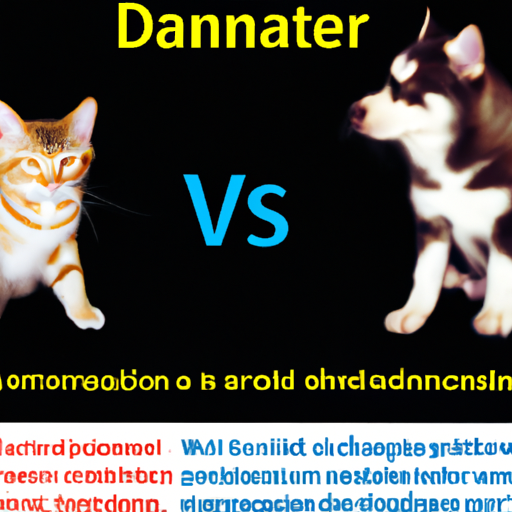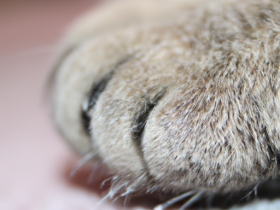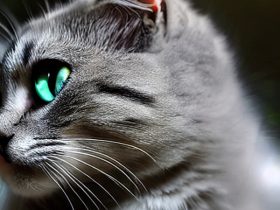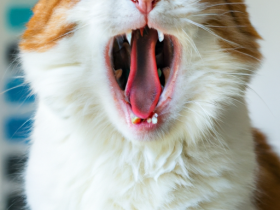why would the dna of cats and dogs be much more similar than the dna of cats and hamsters?
The DNA of cats and dogs is much more similar than the DNA of cats and hamsters because they are both mammals and have similar evolutionary history. Cats and dogs have both evolved from the same ancestor, the wildcat, and are in the same family, Felidae. This means that they have a much closer genetic relationship than cats and hamsters, which are from different families. This is why their DNA is much more similar than the DNA of cats and hamsters.
The Evolutionary History of Cats and Dogs: How They Became So Closely Related
Domesticated cats and dogs are two of the most beloved animals in the world today. Despite their close relationship, they evolved separately over millions of years. To understand how cats and dogs became so closely related, we must look at their evolutionary history.
The evolutionary history of cats and dogs can be traced back to the Middle Pleistocene Epoch, which began around 126,000 years ago. During this period, cats and dogs were two distinct species that evolved in different environments. Cats were adapted to hunting small prey in the forests, while dogs had the ability to hunt larger prey in open plains.
As the climate shifted and the environment changed, cats and dogs began to overlap in their habitats. This allowed them to interact more frequently, leading to hybridization. Through this process, cats and dogs began to share genetic traits, creating new species.
Over time, cats and dogs continued to interbreed, resulting in a variety of domesticated breeds. The modern breeds of cats and dogs are descended from these hybrid species. The domestication of cats and dogs also brought them closer together, as they were often kept as pets and companions.
Today, cats and dogs are considered close relatives and are often seen as family members. This is a testament to their long evolutionary history and the changes that have taken place over the years. While their evolutionary paths may have diverged, cats and dogs have come to share many traits and characteristics that have brought them closer together.
Uncovering the Mysteries of Genome Similarity between Cats and Dogs
Cats and dogs are two of the most iconic and beloved pets in the world. Despite their obvious physical differences, cats and dogs have much more in common than many people realize. In recent years, scientific research has revealed the surprising similarities between cats and dogs at the genetic level.
To begin with, cats and dogs are both members of the same taxonomic family, known as Carnivora. This means that cats and dogs are descended from a common ancestor, and share many of the same basic characteristics. More specifically, cats and dogs possess similar gene sequences, which allows them to share many similar physical traits. For example, cats and dogs both have four legs and a tail, as well as a similar bone structure and organ systems.
At the genetic level, cats and dogs also possess a high degree of similarity. In fact, they share over 90% of the same genetic code. This is particularly remarkable, given the fact that cats and dogs have been evolving separately for millions of years. This suggests that cats and dogs both inherited much of their genetic information from a common ancestor.
The degree of genetic similarity between cats and dogs also explains why they are able to interbreed. While cats and dogs cannot produce viable offspring, cats and dogs can successfully produce hybrid offspring, such as the popular “Maltese” cat-dog mix. This is only possible because cats and dogs share so much of their genetic code.
Overall, cats and dogs are much more similar than most people realize. Thanks to advances in scientific research, we now have a better understanding of the genome similarity between cats and dogs. This research can help us to better understand the history of both animals, and may even lead to new insights into how they evolved.
The Role of Natural Selection in Shaping the Genomes of Cats and Dogs
Cats and dogs are two of the most beloved and popular pets in the world, and their genomes have been shaped over centuries by natural selection. Natural selection is a process by which organisms with advantageous traits for survival and reproduction are more likely to pass on those traits to their offspring. Over time, these beneficial traits become more common in a population, while unfavorable traits are selected against and become less common.
In the case of cats and dogs, natural selection has played a key role in shaping their genomes. For example, cats have been bred to have narrow faces and brains that are adapted to catching small prey, while dogs have been bred to have shorter muzzles and brains that are adapted to understanding human commands. Through natural selection, cats and dogs have evolved distinctive characteristics that make them better suited for their respective environments.
Natural selection has also been responsible for the diversity we see in cats and dogs today. Through selective breeding, humans have been able to create a wide variety of breeds, each with its own unique set of traits. For example, some breeds of cats are better suited for hunting, while others are better suited for companionship. Similarly, some breeds of dogs are better suited for herding, while others are better suited for protection.
Ultimately, natural selection has played an important role in shaping the genomes of cats and dogs. Through the process of natural selection, cats and dogs have evolved to become the unique and varied creatures that we know and love today.
Exploring the Genetics Behind the Similar DNA between Cats and Dogs
As humans, we have always been fascinated by the close similarities between cats and dogs. While it is often said that cats and dogs are as different as night and day, the truth is that they share a great deal of genetic similarities. In this article, we will explore the genetics behind the similar DNA between cats and dogs, and uncover why they are so closely related.
To begin, it is important to understand that cats and dogs belong to the same family, Felidae. This means that they share a common ancestor that split into two separate lineages millions of years ago. This is why cats and dogs share many of the same physical characteristics, such as fur, paw pads, and whiskers.
It is also important to understand that cats and dogs have similar genetic makeups. In fact, they share a whopping 90% of their genes, which is more than humans and chimpanzees share! This is because cats and dogs have similar DNA sequences, which is the code that determines their genetic makeup.
The similarities in cats and dogs’ DNA can be further broken down into specific genes. For example, both cats and dogs have genes that code for physical traits like fur color and body size. They also have genes that code for behavior, such as aggression and curiosity.
Finally, cats and dogs have similar genetic sequences involved in the production of proteins. Proteins are the building blocks of cells and organs, and are responsible for many of the body’s functions. By having similar genetic sequences, cats and dogs can use the same proteins to build their bodies in the same way.
Overall, cats and dogs share a surprising amount of genetic similarities. This is due to their common ancestor, as well as the fact that they share many of the same genetic sequences. This explains why cats and dogs are so closely related, despite their obvious differences.
How the Domestication of Cats and Dogs Led to Their Shared DNA
The domestication of cats and dogs is a fascinating process that has been studied for centuries. It is believed that cats were first domesticated in the Near East about 10,000 years ago. Dogs, on the other hand, were first domesticated in East Asia between 15,000 and 30,000 years ago. Despite their different timelines, cats and dogs have become two of the most popular pets in the world and have a unique bond that has led to them sharing a similar DNA.
The domestication of cats and dogs has led to the animals becoming socialized to humans and has resulted in them being able to live in harmony with each other. This shared environment has caused their DNA to become intertwined and has resulted in the animals sharing certain physical and behavioral traits. One example of this is their shared coat colors, which are primarily black, white, and gray. Additionally, both cats and dogs have a heightened sense of smell, increased agility, and a natural curiosity.
The domestication of cats and dogs has also led to the animals having similar genetic diseases, such as hip dysplasia, heart murmurs, and diabetes. These diseases are caused by a combination of genetic predispositions and environmental factors and can affect both cats and dogs. Because of this, it is important for pet owners to be aware of the potential health risks associated with their pets.
The domestication of cats and dogs has also led to a unique bond between the two species. Dogs and cats are known to be loyal companions and often form strong bonds with their owners. This bond often leads to cats and dogs playing together, cuddling, and even sharing food. This connection between cats and dogs can be seen in their shared DNA, which is a testament to the strong bond that has been formed through domestication.
The domestication of cats and dogs has allowed them to become beloved household pets and has given us a unique insight into their shared DNA. This shared DNA has enabled the animals to share certain physical and behavioral traits, as well as certain genetic diseases. Additionally, the domestication of cats and dogs has also allowed for the animals to form strong bonds with each other and their owners, which is a testament to the powerful connection that has been formed through domestication.
The Science Behind Why the DNA of Cats and Dogs is More Similar than That of Cats and Hamsters
When comparing the DNA of cats and dogs to that of cats and hamsters, it is clear that the former is far more similar than the latter. This is due to the fact that cats and dogs are both members of the family Felidae, while cats and hamsters are not. As a result, cats and dogs share many of the same genetic markers, which is why their DNA is so much more alike than that of cats and hamsters.
The similarities between cats and dogs go deeper than just the genetic level. Cats and dogs are both mammals, meaning they share a common ancestor in the distant past. This common ancestor is what gives cats and dogs many of the same traits, such as fur, whiskers, and sharp teeth. Additionally, cats and dogs share many of the same behaviors, such as purring and barking.
In contrast, cats and hamsters are not even in the same taxonomic order. Cats are in the order Carnivora while hamsters are in the order Rodentia. This is why their DNA is so dissimilar, as the two species have been evolving separately for millions of years.
The fact that cats and dogs are so closely related is why their DNA is so much more similar than that of cats and hamsters. Their shared history and common ancestor have left cats and dogs with many of the same traits, both physical and behavioral. As such, they share many of the same genetic markers, making their DNA very similar.
Conclusion
The DNA of cats and dogs is much more similar than the DNA of cats and hamsters because cats and dogs both evolved from a common ancestor and share a more recent common ancestor compared to cats and hamsters. This close relationship between cats and dogs is reflected in the similarity of their DNA.
When we look at the DNA of cats and dogs, why is it so similar? Why is the genetic makeup of cats and dogs more similar than that of cats and hamsters? The answer lies in evolutionary adaptation and the environments which these creatures inhabit.
Cats and Dogs are both classed as mammals belonging to the same order, Carnivora. This order breaks down into two common suborders; Feliformia, which includes the cats, and Caniformia, which includes the dogs. They share a common ancestor, and subsequently have similar DNA sequences almost identical to each other.
On the other hand, hamsters are primates in the order Rodentia, who generally inhabit different environments to cats and dogs. As a result, they do not share the same evolutionary adaptations and so their genetic makeup is noticeably different to that of cats and dogs.
Due to the distinct evolution of cats and dogs, their genetic makeup is much more similar than that of cats and hamsters. Cats and dogs have a similar physiology and many of the same behavioural traits, making them the basis for an intense bond between the two. Of course, this isn’t to say that cats and hamsters, or dogs and hamsters, can’t have a meaningful relationship.
The similarities in the DNA of cats and dogs, compared to the variability in the DNA of cats and hamsters, are the result of millions of years of evolution. Now, cats and dogs are so genetically similar that they can share homes and even meals with one another.








Leave a Reply
View Comments